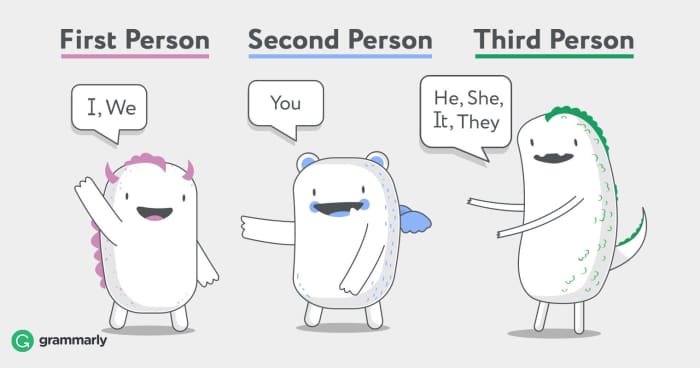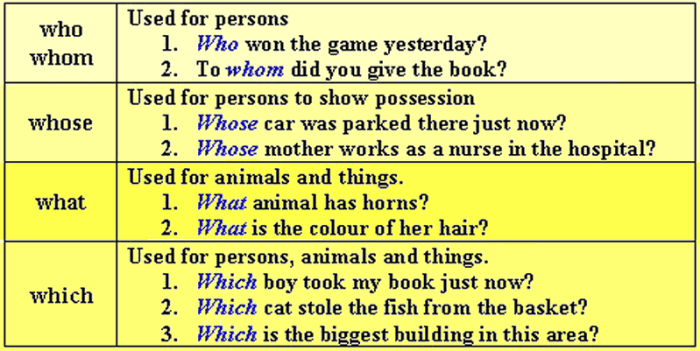Make It Personal: Writing in 1st, 2nd & 3rd Person Formats
1st, 2nd or 3rd?
It's not a race, but the first, second, and third-person refers to a place in that it is the perspective of the person telling the story. It is not limited to storytelling though; it also covers all types of non-fiction writing. It even covers cases in which there is no reference to an actual person.
As well as the perspective of the grammatical person, we also consider their number (is there one or more than one of them?) and gender (see the end of the article for a bonus section on the politics of pronouns).
First Person: It's All About Me
When writing in the first person, I talk about myself, what I did, or if with others, what we did and how it affected us. Writing in the first person can make an account seem more personal. If it is a piece of fiction, the narrator tells the story as they saw it. In non-fiction, such as a CV or report, it is a factual account of what the writer has done, in their own words.
When writing in the first person, we must consider whether we use the singular or plural form:
1st Person Pronouns
| Pronoun | Person |
|---|---|
I | First person singular |
we | First person plural |
us | First person plural * |
Second Person: It's All About You
In standard English, the only word you need for the second person is "you". It is both the second person singular and plural forms. That's it - it's all about you.
Third Person: It's All About Them
The third person complicates things. First and second person are relatively easy to understand and use, but the third person has different forms based on the number of persons, and its gender (or lack of gender).
Generally, the third person is used to speak about someone, or something else; him, her, it, they. It is very commonly used, and you probably don't even think about it. Most newspaper articles are written in the third person, because they are describing events from afar, and are reporting news to everyone, rather than speaking directly to you, the reader. Some magazine articles will use the second person, giving a more informal feel.
3rd Person Pronouns
| Pronoun | Person |
|---|---|
he | third-person singular, masculine |
she | third-person singular, feminine |
it | third-person singular, neuter/inanimate * |
they | third-person singular, gender-neutral |
they | third-person plural |
them | third-person plural ** |
* "it" used as third-person singular pronoun is never used for people. It would be highly offensive to refer to another human as "it". "It" in this context is for inanimate objects, concepts, and occasionally animals - although I still feel weird about referring to pets as "it" - I'd rather use a gendered or gender-neutral pronoun.
** "them" used in the third person is often informal / colloquial, but not always.
It's About More Than Us & Them
In addition to the personal pronouns, there are other types of pronoun that don't fall neatly into categories one, two, or three (although all pronouns are spoken in one of the three person categories). We also use these all the time without really considering them. These include:
- Generic "You" (which would make an excellent song title)
- Relative Pronouns
- Demonstrative Pronouns
- Indefinite Pronouns
- Reflexive & Intensive Pronouns
- Interrogative Pronouns
- Possessive Pronouns
- Subject & Object Pronouns
I use generic you in most of my HubPages articles. I'm using it now, to address you, the reader. I don't know who individual members of my audience are, but my message is delivered to all of you as the whole audience generally. To use generic you in the written form is considered informal, a more conversational style suitable for use in a magazine format. Spoken, it could be formal or informal - it is used day-to-day, and also in speechwriting, for example.
Recommended
Generic you can also be used in place of the more formal "one", e.g.
"One can see the sea from the top floor of the building" vs. "You can see the sea from the top floor of the building"
The use of "one" in English writing and speech is usually reserved for more formal styles and occasions, but there are many times when a formal style would not require the use of "one". Unlike the French, we do not have separate second-person pronouns for single, plural, formal, and informal "you" *. So in the place of the plural and the formal, we have "generic you".
* Note: The French do have a pronoun similar to the English "one", that is different in meaning to "vous", and closer in meaning to our "one", but that really overcomplicates things! I think it's better to just say that we have no equivalent form of "vous" in English and leave it at that.
It's All Relative: Relative Pronouns
Relative pronouns are words that link a noun to an adjective clause. What is an adjective clause? It's a phrase or group of words that perform the function of an adjective. In any sentence, an adjective can be used to describe a noun or pronoun. We can also write the sentence differently so that the noun or pronoun is described by the same definition, but with a different syntax, using an adjective clause. Here is a simple example to explain the function of an adjective clause. These sentences mean the same thing, but they use words in slightly different ways to convey that meaning.
Relative pronouns can refer to objects, concepts, or people, and include words such as:
that, which, who, whom, whose, whoever, whomever, whichever
Demonstrative Pronouns: This & That
Demonstrative pronouns are words used to identify objects or people. The choice of pronoun depends on both the number of them, and their proximity.
- We use "this" (singular) and "these" (plural) for things or people that are nearby.
- We use "that" (singular) and "these" (plural) for things and people that aren't in the immediate vicinity.
When we talk about distance, we can mean it in both a literal and figurative sense. We might refer to a group of people that we do not know ("who are those people?") even though they could be in the same room as us, for example.
Talking about things nearby:
- "This is my jumper."
- "Whose notes are these?"
- "We have lived in this flat since January."
- "Have you read all of these books?"
Talking about people who are nearby:
- "This is Barry."
- "These are my sisters, Edith and Matilda."
- "Thank you for joining us at today's meeting; this is Richard, and this is Mary."
- "Hello, this is Katy, may I speak to Julia?
Talking about things that are not nearby:
- "What’s that?"
- "This is my house, and that’s Julian’s house over there."
- "Those are very expensive dresses."
Talking about people that are not nearby:
- "Who owns that car?"
- "Who are those people?"
"That" can be used to talk about concepts or actions:
- "Would you like to go to the park?" "Yes, that’s a good idea."
- "I’ve got a new job!" "That’s great!"
- "I’m just so tired these days." "Why is that?"
Indefinite Pronouns
Definite pronouns are used when there is a known thing or person being described: him, her, it, that. Indefinite pronouns are when we describe something more vague, or talking about someone or something in more general terms. They are occasionally second-, and usually third-person, and can be singular or plural.
These include (singular): anybody, anyone, someone, something, anything, either, neither, everybody, everyone, each, everything, nobody, no-one, nothing, somebody, one, all, any, most, none, some.
And (plural): Few, both, many, several, all, any, some, none, most.
Reflexive Pronouns
Reflexive pronouns are used to refer to the word that it immediately follows or precedes. They tend to end in "-self" or "-selves". A reflexive pronoun is normally used when the object of a sentence is the same as the subject, and is a modified form of a non-reflexive pronoun. Some examples:
| Pronoun | Reflexive Form |
|---|---|
I | myself |
me | myself |
we | ourselves |
you | yourself / yourselves |
him | himself |
her | herself |
it | itself |
one | oneself |
them | themselves |
they | themselves |
us | ourselves |
Intensive Pronouns
Intensive pronouns are used to add emphasis to a statement, for example compare "I did it" with "I did it myself". Intensive pronouns use the same form as the reflexive pronouns, but they are used differently. If an intensive pronoun is removed from a sentence, the sentence should still make logical sense, even though its meaning has changed - this would not be the case for a sentence using the reflexive form.
Interrogative Pronouns
These are the words who, whom, whose, what, and which. They are used to ask questions, and refer to a person or thing in order to gain more information about it. When used in a sentence, the interrogative pronoun is the object or subject of the sentence that we wish to know about. This can be seen more clearly with some example questions:
- "Who saw you?"
- "Dave saw me." ("Dave" is the subject of this sentence)
- "Whom did you tell?"
- "I told Lily." ("Lily" is the object of this sentence)
We use "whom" when we are enquiring about the object of inquiry, and "who" when we are asking about the subject of inquiry. There is more information on this in the section below. In general conversation, using "who" for both is usually acceptable, but it would not be appropriate in a formal context. Whom can be made even more formal, by preceding it with a preposition, such as "in, to, on, or with":
- "To whom it may concern"
- "the other suspects, with whom you are charged"
As mentioned earlier in this article, who and whom can be used as relative pronouns, to link parts of a sentence together.
If we are talking about a quantity of a thing, then whom often is necessary (and to use who is incorrect). This might be in the form of "all of", "most of", "some of", etc. For example:
- "The children in detention, both of whom have been late every day this week, will need to study for two extra hours after school." (It would be incorrect to say "both of who".)
"What", "which", and "whose" can be used for the subject or object of a sentence. When using "what" and "which", we must consider the format of the answer that we are looking for. We use "what" when we ask about a specific item(s) from a broad range of possible answers. We use "which" we were asking about item(s) from a finite list of choices:
- "What do you want?" "I want a cup of tea, please." ("Cup of tea" is the object of this sentence, and there are many undefined possibilities to choose from.)
- "What just happened?" "An earthquake's happened." ("Earthquake" is the subject of this sentence, and there are many possibilities as to what could have just happened.)
- "Which came first?" "The chicken, I reckon." ("Chicken" is the subject of this sentence, and presumably we are only choosing from chicken or egg.)
- "Which will you use first?" "I will probably use the green paint, as there's enough to complete that small room." ("Green paint" is the object of this sentence, and the selection is from the available colours of paint.)
- "There's one van missing. Whose hasn't arrived?" "Shirley's van isn't here." ("Shirley" is the subject of this sentence.)
- "We've found everyone's name tags. Whose did you find?" "I found Rita's." ("Rita" is the object of this sentence.)
If we want to add emphasis to who, what, or which, we can add the suffix "-ever" like so:
- Whatever did she say to make him cry like that?
- Whoever would do such an awful thing?
- They're all great! Whichever will you choose?
Possessive Pronouns
Possessive pronouns denote ownership. They include: my, mine, our, ours, your, yours, its, his, her, hers, their & theirs. If a possessive pronoun is used before a noun, it acts as an adjective. They can also be used on their own, and still convey the intended meaning.
Types of Possessive Pronoun
| To use before a noun | Standalone possessive pronouns |
|---|---|
my | mine |
our | ours |
your | yours |
its | -- |
his | his |
her | hers |
their | theirs |
Here are some examples of possessive pronouns used in a sentence (Source: http://examples.yourdictionary.com/examples-of-possessive-pronouns.html)
- The kids are yours and mine.
- The house is theirs and its paint is flaking.
- The money was really theirs for the taking.
- We shall finally have what is rightfully ours.
- Their mother gets along well with yours.
- What's mine is yours, my friend.
- The dog is mine.
- The cat is yours.
- The ring is hers.
- The bag is theirs.
Subject & Object Pronouns
In a sentence, the subject is the thing or person performing an action. The object is the thing or person having an action performed on it.
Subject pronouns act as the subject and perform the action in a sentence. For example:
"On Tuesdays, I make bread." "I" is the subject pronoun, and "make" is the verb, carrying out the action.
Object pronouns act as the object, and have an action done to them. For example:
"I gave him some of my bread." In this sentence, the order is different. "Gave" is the verb, the action being done to "him", the object pronoun.
| Subject Pronoun | Object Pronoun |
|---|---|
I | me |
we | us |
you | you |
he | they |
she | they |
it | they |
they | they |
Political Language, and Third Person Singular "They"
I did promise an overview of this topic at the start of the article (I do hope that you were paying attention!). It has become more relevant nowadays because of increased awareness of transgender and non-binary people, for whom the standard gendered pronouns may not be accurate. There are many new pronoun systems, which I do find difficult to understand in terms of pronunciation, but I do try to use them correctly (it's a matter of being polite, and if you refuse then you're just being a jerk). There is a very good summary of the different types, and their history, here:
'Ze' or 'They'? A Guide to Using Gender-Neutral Pronouns
I tend to prefer third-person singular 'they', both for myself and when referring to others. Not because I think my way is better, but because it comes in very useful in many situations. Think of all the times you've needed to write 'he/she' or '(s)he' because you weren't sure of a person's gender. It can happen a lot: maybe you are talking about a professional that you intend to hire, an architect, or lawyer, maybe. When discussing that person prior to knowing who they are, it would make perfect sense to use third-person singular 'they' when referring to them (see, I did it there when I used 'them'). Or perhaps you know someone's name, and are corresponding with them only in the written form (you've never met them). They (I did it again!) just so happen to have an unfamiliar name and you don't want to embarrass yourself by misgendering them. Third-person singular 'they' can come to your rescue! It's extremely useful and versatile, as demonstrated in the video below:
In Summary
I have covered a lot of ground in this article - all you could ever wish to know about pronouns, and then some more! Starting with the definition of first, second, and third person pronouns, we then moved on to other categories of pronoun, that are still one of the three personal types, but also have additional characteristics. Many pronouns will fall into more than one category. It can be difficult to keep track of, so here is a summary of the basics:
| Pronoun | Examples |
|---|---|
First Person | I, we, us |
Second Person | you |
Third Person | he, she, it, they, them |
Generic You | used when speaking to an audience |
Relative Pronouns | that, which, who, whom, whose, whoever, whomever, whichever |
Demonstrative Pronouns | this, those, that, these |
Indefinite Pronouns | anybody, anyone, someone, something, anything, either, neither, everybody, everyone, each, everything, nobody, no-one, nothing, somebody, one, all, any, most, none, some, few, both, many, several, all, any, some, none, most. |
Reflexive and Intensive Pronouns | myself, ourselves, yourself, yourselves, himself, herself, itself, oneself, themselves |
Interrogative Pronouns | who, whom, whose, what, which |
Possessive Pronouns (combined with a noun) | my, our, your, its, his, her, their |
Possessive Pronouns (standalone) | mine, ours, yours, his, hers, theirs |
Subject Pronouns | I, we, you, he, she, it, they |
Object Pronouns | me, us, you, they |
Suggested Reading
- Which Versus That: Grammar Errors
Mrs. Twitches explains the rules for using WHICH and THAT. You might find yourself scratching your head at her rhymes and uncommon explanations for which and that and their respective clauses. - Me, Myself or I - Grammar Errors, Rules, Questions
Do you know how to use the word "myself?" Incorrect use of "myself" will not be tolerated ... by me, myself or I! - Whose Versus Who's: Common Grammar Mistakes
Do you get confused between "whose" and "who's"? Fear no longer. Many writers get confused, but there's an easy way to keep it straight. Learn the difference between "whose" and "who's" with examples of when and how to use these words in a sentence.
© 2017 Katy Preen
Comments
Katy Preen (author) from Manchester, UK on May 11, 2017:
Thank you!
Penny Leigh Sebring from Fort Collins on May 10, 2017:
Well written grammar guide on this subject Katy. Both in-depth and concise.










